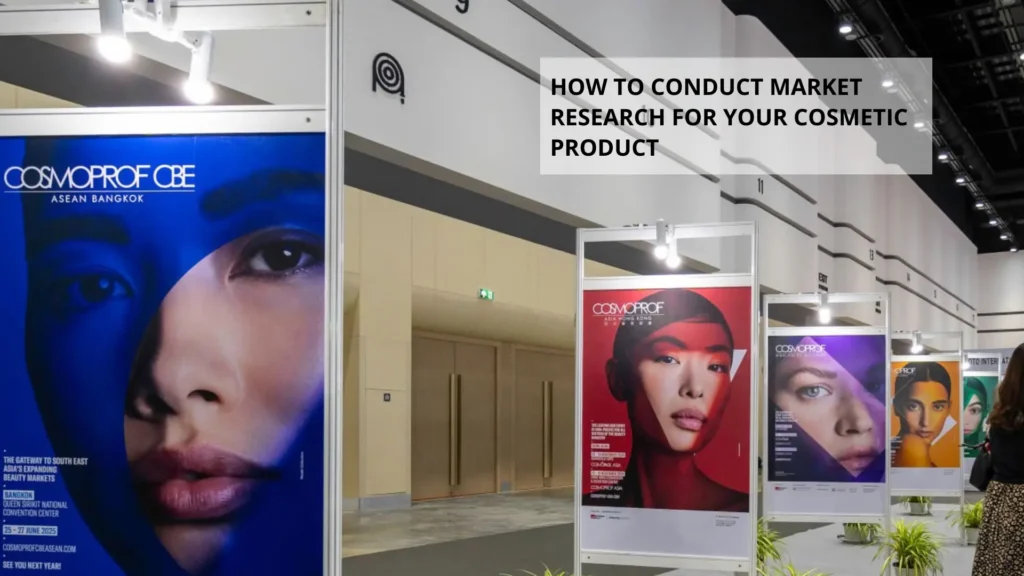📘 By Biocylab Blog | May 2025
🕒 Reading Time: 7–9 minutes

In a highly saturated and competitive beauty industry, launching a cosmetic product without conducting market research is like setting sail without a compass. Understanding your audience, analyzing the competition, testing product concepts, and using data to guide your strategy are all essential steps that separate thriving brands from those that disappear quietly. This guide walks you through the essentials of conducting market research for a successful beauty product launch.
Introduction
Market research isn’t just a business checkbox—it’s the foundation of a winning product strategy. Whether you’re creating a skincare line, a makeup collection, or a haircare innovation, knowing who you’re selling to, what they’re looking for, and why your solution stands out is critical.
Skipping this stage can lead to poor product-market fit, misaligned pricing, ineffective marketing, and ultimately—failure to sell. Let’s look at how to build a data-driven approach to product development in the beauty industry.
Step 1: Understanding Your Target Audience
Defining Your Ideal Customer
Start by asking yourself: Who is this product for? Your ideal customer profile should go far beyond gender and age. Dive into psychographics: their lifestyle, values, preferences, and pain points.
- Do they prioritize natural ingredients?
- Are they dealing with specific skin concerns?
- Are they price-sensitive or do they seek luxury?
Tools for Customer Insight
- Google Trends: Understand how interest in certain beauty trends or ingredients evolves over time.
- Meta (Facebook/Instagram) Audience Insights: Analyze behaviors, interests, and demographics.
- Surveys & Interviews: Use tools like Typeform, Google Forms, or in-person interviews to gather qualitative feedback.
The more you know about your consumer, the more targeted your branding, formulation, and marketing can be.
Step 2: Analyzing Competitors
Competitive Landscape Analysis
Research your top competitors—both global giants and niche indie brands. Look at:
- Their best-selling products.
- Their brand positioning and price points.
- Their customer reviews (on Amazon, Sephora, or social media).
- Their packaging and communication style.
Finding Gaps and Opportunities
Ask yourself:
- What are customers complaining about in existing products?
- Is there an underserved audience or unaddressed need?
- Can you innovate through formulation, packaging, or brand values?
Tools to Use:
- SEMrush or Ahrefs for analyzing competitor traffic and keywords.
- Instagram/TikTok to see which product videos are trending.
- Review mining on marketplaces and beauty forums like Reddit or MakeupAlley.
Step 3: Primary vs. Secondary Research
Primary Research involves collecting new data directly from your audience.
Examples:
- Surveys & Focus Groups: Ask questions about preferences, pricing, packaging, or even brand names.
- In-Store or Online Interviews: Get real-time reactions to sample products or prototypes.
Secondary Research uses data already collected by other entities.
Examples:
- Industry Reports from Mintel, Statista, Euromonitor, or Allied Market Research.
- Market Trends Reports from beauty platforms like Trendalytics or WGSN.
Why Both Matter:
Primary research gives you custom insights, while secondary research gives you scale and trends. Use both for a well-rounded view of the market.
Step 4: Testing Product Concepts and Ideas
Validate Before You Invest
Before investing in full production, test your concept with your target audience. This includes:
- Mock-ups or Prototypes: Share early packaging or formulation samples with a select group.
- Beta Launches: Launch a limited edition and gather feedback on scent, texture, results, or packaging.
- Landing Pages or Pre-orders: Create a waitlist or a sales page to measure real interest.
Feedback is Gold
Ask for feedback on:
- Product effectiveness and sensorial experience.
- Visual appeal and unboxing.
- Price perception and value.
Use this input to improve the product, refine your messaging, and even pivot if needed.
Step 5: Using Data to Make Informed Decisions
Data Alone Is Not Enough—Interpret It Wisely
Once you’ve collected your research, the next step is using it strategically.
- If your data shows a preference for minimalist, eco-packaging—reflect that in your design.
- If surveys highlight strong demand for paraben-free or vegan formulas—highlight those claims clearly.
- If price sensitivity is an issue—consider offering tiered pricing or bundles.
Your decisions around branding, formulation, pricing, and distribution should all be guided by real insights—not assumptions.
KPIs to Monitor Post-Launch
- Conversion rates from product pages.
- Engagement rates on social media.
- Repurchase rates and customer reviews.
- Competitor moves and new market trends.
Conclusion
Launching a cosmetic product without research is like shooting in the dark. Market research is your guiding light—it reduces risk, sharpens your value proposition, and connects you deeply with your audience.
And remember: market research is not a one-time task. As trends shift, competitors evolve, and your customer base grows, your insights should evolve too. Staying curious and data-driven is what will keep your brand competitive in the fast-paced beauty industry.
✅ Ready to validate your cosmetic product idea?
Biocylab can help you test formulations, gather consumer insights, and build a launch strategy backed by data. Let’s talk!

